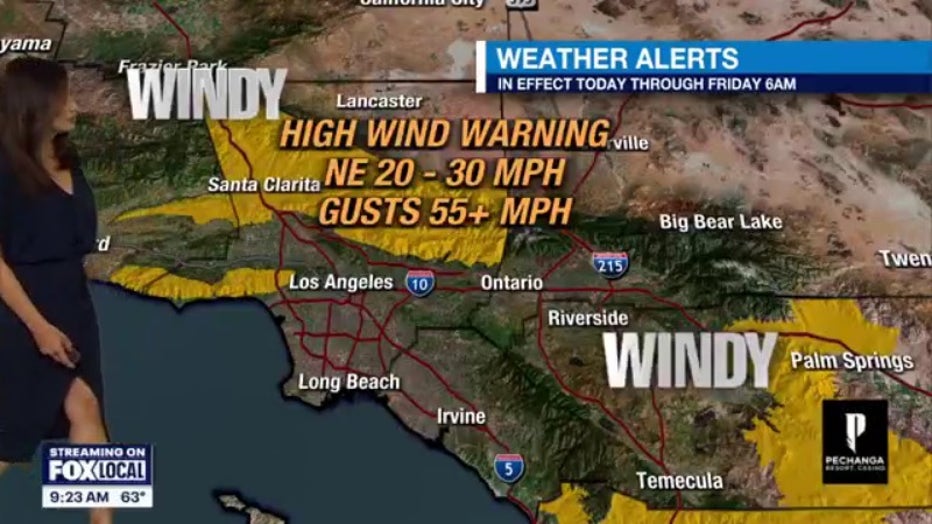Forecast: Red flag warnings still in place; more wind coming next week

Weather forecast for Friday, Jan. 10
The supersized Santa Ana winds have died down for now, but critical fire weather conditions remain and red flag warnings are in place for much of Southern California.
The fierce winds that fueled massive, deadly wildfires in the Los Angeles area subsided Friday, but critical fire weather conditions remain and red flag warnings are still in place for much of Southern California.
FOX LA meteorologist Maria Quiban said some areas are still seeing gusts of up to 60 mph Friday morning, but it’s expected to diminish by Friday afternoon.
RELATED: How do you measure wildfire containment?
The wind is also expected to change direction Saturday, bringing more of an onshore flow that will increase humidity – but also change the direction of the flames.
RELATED: California fires map: Los Angeles evacuation orders, warnings
Firefighters were still battling five major fires Friday, including the Palisades, Eaton, Kenneth, Hurst and Lidia fires. At least 10 people were killed, but that number is expected to climb.
Red flag warnings
Although wind speeds have diminished, red flag warnings are in place until 6 p.m. Friday for much of Southern California. That means critical weather conditions remain and the fire risk is still very high.
"Please still stay vigilant, be ready with your Ready, Set, Go fire plan," Quiban said.
RELATED: "No human being" sending out erroneous fire alerts, officials claim
Some areas north and west of Los Angeles are still under high wind warnings as of Friday morning.

Air quality alert
Air quality has reached hazardous levels in the Los Angeles area, officials said. The smoke advisory was extended through Friday.
RELATED: How to make a DIY air filter with a box fan
Officials on Friday urged residents to remain indoors as much as possible, avoid outdoor physical activity and run air purifiers or AC if you have them.

Accidental emergency alerts sent by computer, not 'human-driven'
L.A. County Office of Emergency Management Director Kevin McGowan addressed the issue of the accidental emergency alerts that were sent to every LA County resident.
Wind returns next week
The forecast calls for moderate to strong winds to return to the Los Angeles area Monday afternoon into Tuesday, which could spark new fires and make it harder for firefighters to contain any that may still be burning next week.
RELATED: Map: Eaton Fire prompts do-not-drink order for these Pasadena residents
"We know that we’re going to have a possible increase in the force of the winds at the beginning of next week and we’re getting Los Angeles prepared, doing everything we can to save lives, that is our number one job to protect people’s homes, to protect people’s businesses and to prepare to rebuild Los Angeles in a much better way," Los Angeles Mayor Karen Bass said at a briefing Friday morning.

40% of Palisades leveled by firestorm
Approximately 40% of the Pacific Palisades community was destroyed in the deadly firestorm.
A low-pressure system forming offshore could bring light showers Wednesday and Thursday.
What caused the fires?
The exact cause of each fire is still under investigation, but officials have largely blamed the extreme drought conditions, combined with the supersized Santa Ana winds that whipped flames and embers at 100 mph – much faster than usual.
RELATED: What caused the California fires? What we know
Add on weather whiplash that grew tons of plants in downpours, then record high temperatures that dried them out to make easy-to-burn fuel. Then there’s a plunging and unusual jet stream, and lots of power lines flapping in those powerful gusts.

LAPD discusses arrest made near Kenneth Fire area
LAPD Assistant Chief Dominic Cho says the man taken into custody in Woodland Hills Thursday is still being investigated but at this time to not have enough evidence to arrest him for arson.
Experts say that’s what is turning wildfires into a deadly urban conflagration.
While lightning is the most common source of fires in the U.S., according to the National Fire Protection Association, investigators were able to rule that out quickly. There were no reports of lightning in the Palisades area or the terrain around the Eaton fire, which started in east Los Angeles County and has also destroyed hundreds of homes.
The next two most common causes: fires intentionally set, and those sparked by utility lines.

